(完整版)人教版八年级下册unit6.教案
- 格式:pdf
- 大小:125.17 KB
- 文档页数:4
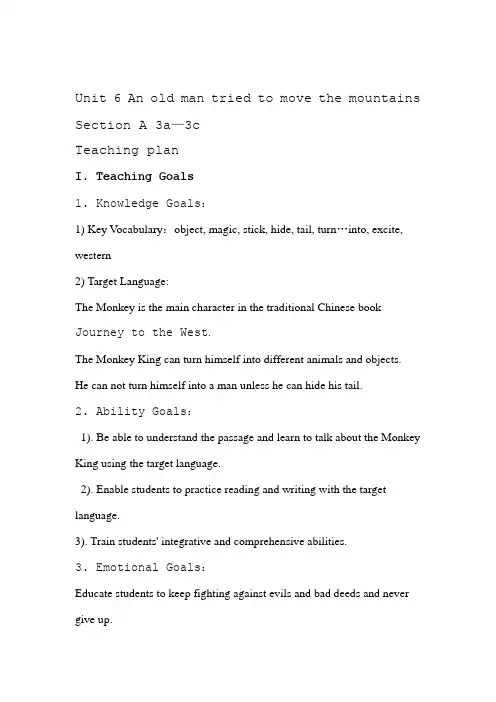
Unit 6 An old man tried to move the mountains Section A 3a—3cTeaching planI. Teaching Goals1. Knowledge Goals:1) Key V ocabulary:object, magic, stick, hide, tail, turn…into, excite, western2) Target Language:The Monkey is the main character in the traditional Chinese bookJourney to the West.The Monkey King can turn himself into different animals and objects.He can not turn himself into a man unless he can hide his tail.2. Ability Goals:1). Be able to understand the passage and learn to talk about the Monkey King using the target language.2). Enable students to practice reading and writing with the target language.3). Train students' integrative and comprehensive abilities.3. Emotional Goals:Educate students to keep fighting against evils and bad deeds and never give up.II. Key points and difficult points1. Key Vocabulary:object, magic, stick, hide, tail, turn…into, excite, western2. Key Expressions:The Monkey is the main character in the traditional Chinese book Journey to the West.The Monkey King can turn himself into different animals and objects.He can not turn himself into a man unless he can hide his tail.3. Difficult Points:Be able to understand the fairy story and tell their favorite story with target language.III. Teaching steps.1. Greetings2. Review: Do you know these traditional stories of China?3. Watch a video4. Talk about the four main characters especially the Monkey King.5. How much do you know about the Monkey King?6. Teach the new words by showing some pictures.New words: hide—hid, turn…into, object, magic stick, tail, excite, western.7. While reading: Task 1: SkimmingRead the passage quickly and finish answering the question and matchthe main idea with each paragraph. They have two minutes. Question: Which book is talked about?Match the main idea.Paragraph 1 Western children are also becoming interested in thestories of the Monkey King.Paragraph 2 The Monkey King is new to pupils in England but notto Chinese children.Paragraph 3 The Monkey King is not just normal monkey. He can do magical things.8. Check the answer.9. While reading: Task 2: Careful reading.Read paragraph 1 and tell T or F in two minutes.1). In November 1978, pupils in England were able to watch a new TV program called Monkey. ()2). Most of them were hearing this story for the second time. ()3). The Monkey King is the main character in the traditional Chinese book Journey to the west. ()Ask three students to tell their answers. If it is true, move to the next one, if it is false, ask the students to tell the correct answer. Then read the three sentences together.10. Careful reading: Read paragraph 2 and finish the mind map. Time limit: 2 minutes.11. Check the answer.12. Read paragraph 3 and finish another mind map. Then check the answer.13. Finish 3c. Check the answer after they finish it. Read these sentences together.14. Game: House of card. (Optional)1). Tell the rules of the game: Choose a card. If you are lucky enough you can get into the house directly and get some points. If you choose a number and you are asked to answer a question, then you have to answer it correctly to get some points. If you don't give the right answer, there will be no points for you. And if you give up, no points either.2). Play the game.15. Read the passage while listening. Pay attention to the pronunciation.16. Discussion: What do you think of the Monkey King? What is he like? Ask Ss to talk about their own opinion freely.17. Summary: We talk about the main character the Monkey King from Journey to the West. He can do many things, but he cannot turn himself into a man unless he can hide his tail. His spirit should be learned by children both from China and Western countries.18. Homework: 1). Tell your family or classmates about the Monkey King in English. 2). Try to recite the passage.Remember: Never give up and be helpful. Where there is a will, there is away.19. Blackboard design.Unit 6 An old man tried to move the mountains. Section A 33cWords or expressions(Optional)Evaluation System。
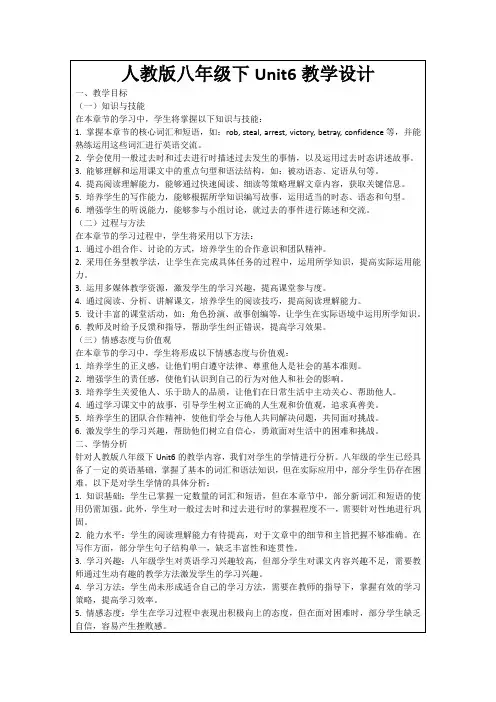
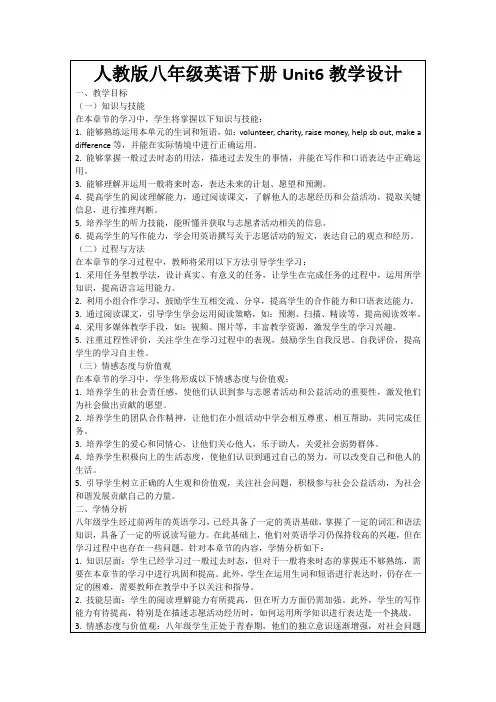
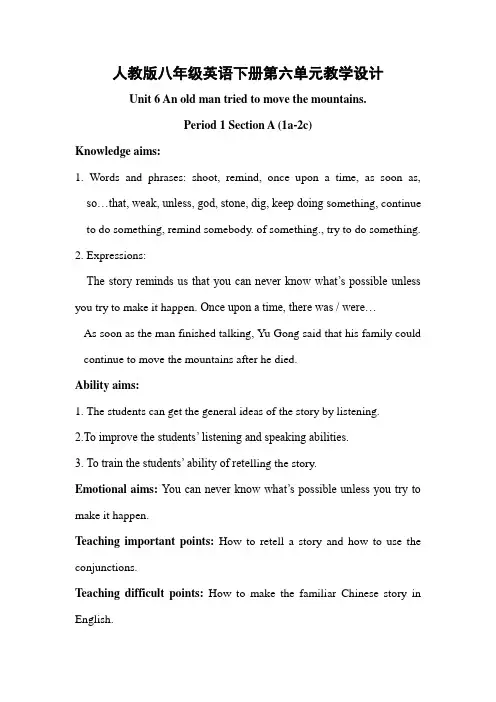
人教版八年级英语下册第六单元教学设计Unit 6 An old man tried to move the mountains.Period 1 Section A (1a-2c)Knowledge aims:1. Words and phrases: shoot, remind, once upon a time, as soon as, so…that, weak, unless, god, stone, dig, keep doing s omething, continue to do something, remind somebody. of something., try to do something.2. Expressions:The story reminds us that you can never know what’s possible unless you try to make it happen. Once upon a time, there was / were…As soon as the man finished talking, Yu Gong said that his family could continue to move the mountains after he died.Ability aims:1. The students can get the general ideas of the story by listening.2.To improve the students’ listening and speaking abilities.3. To train the students’ ability of rete lling the story.Emotional aims: You can never know what’s possible unless you try to make it happen.Teaching important points: How to retell a story and how to use the conjunctions.Teaching difficult points: How to make the familiar Chinese story in English.Teaching aids: CAI , pptTeaching Steps:Step 1 warming up1. Show some pictures of the Chinese story.2. 1a. Students enjoy the pictures and say the names of the four pictures in 1a.Step 2 Presentation & talk1. Show on the screen some pictures about Yu Gong and play the song “愚公移山”.Students talk something about Yu Gong and then enjoy the song.Eg. Yu Gong was born in the Western Zhou Dynasty.2. The reason why Yu Gong wanted to move the mountains was that there were two big mountains near his house and they were so big and high that it took a long time to walk to the other side.Step 3 Listening (1b)1. Get the students to listen and check the facts they hear.2. Listen again and check the answer.Step 4 Discussion (1c)Discuss the questions in pairs first, then ask some pairs to make dialogues by asking and answering.Step 5 Listening1. (2a) Listen to the story about Yu Gong, and number the pictures 1-4 inorder to tell the story.2. (2b) Listen again and circle the words you hear.3. Check the answers.Step 6 Activity 2c1. Get students to retell the story of Y u Gong according to the information in 2b.Students should use the conjunctions like: as soon as.2. Ask several students to retell the story of Yu Gong Moves the Mountains in their own words.Step 7 HomeworkRetell the story of “Yu Gong Moves a Mountain”Blackboard Design教学反思:本课的教学内容以学生所知道的故事为话题,并运用图片、动画、声音媒体等手段进行教学,营造良好的语言学习情境,达到了预期目标。
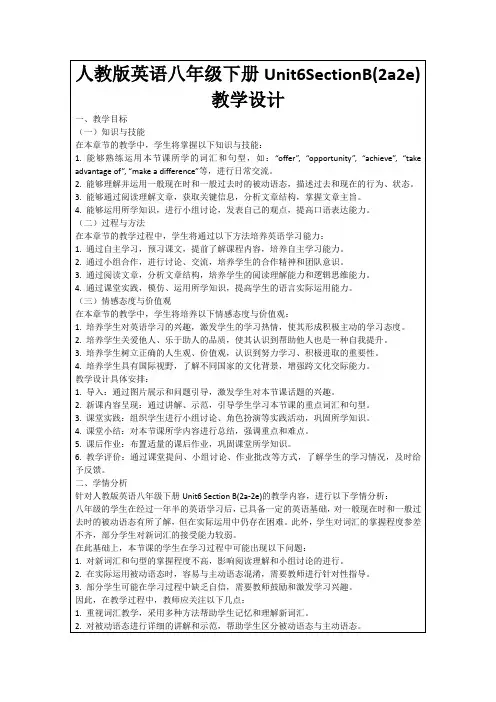
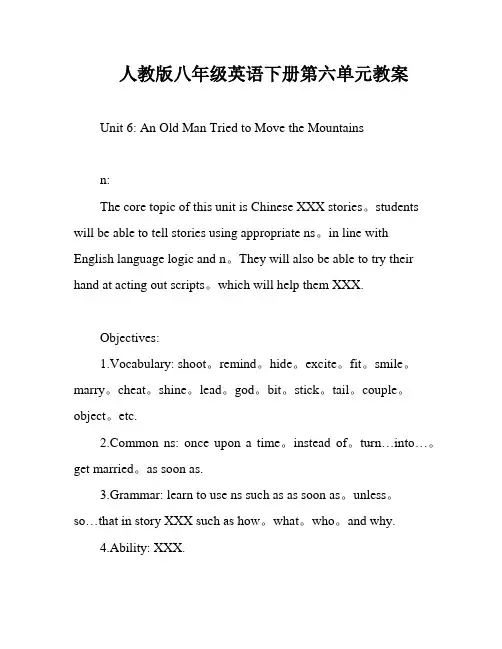
人教版八年级英语下册第六单元教案Unit 6: An Old Man Tried to Move the Mountainsn:The core topic of this unit is Chinese XXX stories。
students will be able to tell stories using appropriate ns。
in line with English language logic and n。
They will also be able to try their hand at acting out scripts。
which will help them XXX.Objectives:1.Vocabulary: shoot。
remind。
hide。
excite。
fit。
smile。
marry。
cheat。
shine。
lead。
god。
bit。
stick。
tail。
couple。
object。
etc.mon ns: once upon a time。
instead of。
turn…into…。
get married。
as soon as.3.Grammar: learn to use ns such as as soon as。
unless。
so…that in story XXX such as how。
what。
who。
and why.4.Ability: XXX.Process and Methods:XXX materials。
adjust and select the teaching content based on the actual level and language ability of the students。
reasonably arrange the number of hours for this unit。
and design the teaching content for each hour.Attitude and Values:1.XXX n。
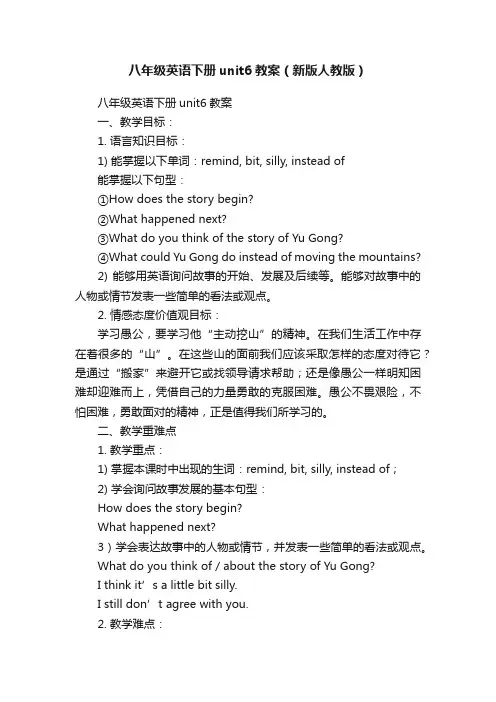
八年级英语下册unit6教案(新版人教版)八年级英语下册unit6教案一、教学目标:1. 语言知识目标:1) 能掌握以下单词:remind, bit, silly, instead of能掌握以下句型:①How does the story begin?②What happened next?③What do you think of the story of Yu Gong?④What could Yu Gong do instead of moving the mountains?2) 能够用英语询问故事的开始、发展及后续等。
能够对故事中的人物或情节发表一些简单的看法或观点。
2. 情感态度价值观目标:学习愚公,要学习他“主动挖山”的精神。
在我们生活工作中存在着很多的“山”。
在这些山的面前我们应该采取怎样的态度对待它?是通过“搬家”来避开它或找领导请求帮助;还是像愚公一样明知困难却迎难而上,凭借自己的力量勇敢的克服困难。
愚公不畏艰险,不怕困难,勇敢面对的精神,正是值得我们所学习的。
二、教学重难点1. 教学重点:1) 掌握本课时中出现的生词:remind, bit, silly, instead of;2) 学会询问故事发展的基本句型:How does the story begin?What happened next?3)学会表达故事中的人物或情节,并发表一些简单的看法或观点。
What do you think of / about the story of Yu Gong?I think it’s a little bit silly.I still don’t agree with you.2. 教学难点:学会表达故事中的人物或情节,并发表一些简单的看法或观点。
三、教学过程Step 1 Lead in1. 播放动画片《寓公移山》的视频,导入本单元主题。
T: What’s the name of the story?S1:It’s Yu Gong moves a mountain.S2: It’s a traditional Chinese story.T: Do you know other traditional Chinese stories?S1: Ne Zha Conquers the Dragon KingS2: Magic Brush Ma LianS3: Chang’e Flies to the Moon…Step 2 Presentation1. 引导学生们学习生词。
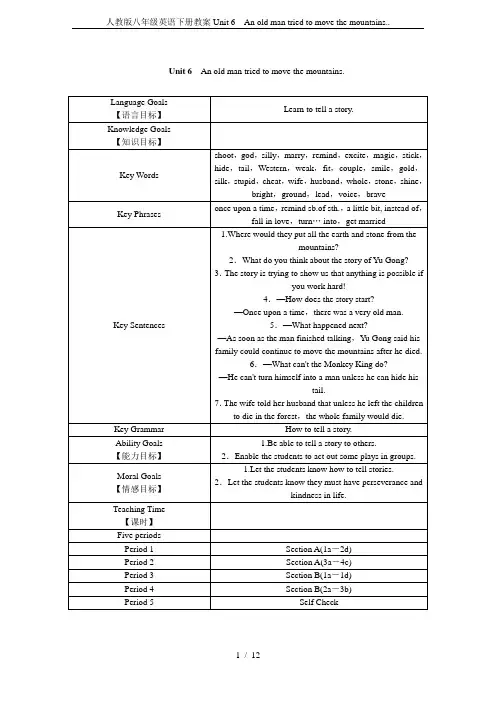
Unit 6An old man tried to move the mountains.本单元教材以“谈论故事情节”为中心话题,围绕着学生非常熟悉的故事进行,学习和运用几个常见的句型:Where would they put all the earth and stone from the mountains?/What do you think about the story of Yu Gong?/The story is trying to show us that anything is possible if you work hard!/—How does the story start?—Once upon a time,there was a very old man./—What happened next?—As soon as the man finished talking,Y u Gong said his family could continue to move the mountains after he died.等。
在学习过程中,学生在交流中,能促进师生之间的感情。
Section A 主要学习once upon a time,remind sb.of sth.,a little bit, instead of,turn… into,get married等几个常见的短语及怎样讲故事。
通过短文介绍了《西游记》在英国放映的事情,增加了学生的阅读量。
Section B 安排了听、说、读、写的任务,通过《皇帝的新装》来训练学生的听力,通过《韩赛尔与格雷特》训练学生的阅读能力。
教师在教学中应合理利用课本上的知识进行教学。
第一课时Section A(1a-2d)Teaching Key Points【教学重点】The vocabulary:shoot,stone,weak,god,silly,remind sb.of sth.,a little bit, instead ofTarget language:1.Where would they put all the earth and stone from the mountains?2.What do you think about the story of Yu Gong?3.The story is trying to show us that anything is possible if you work hard!Teaching Difficult Points【教学难点】Use the target language above to tell a story.Teaching Aids【教学工具】an English book,a tape recorder and CAITeaching Steps【教学过程】★Step 1Preview and perception【预习感知】Ask the students to read the vocabulary and target language.Ⅰ.根据句意及汉语或首字母提示写单词。
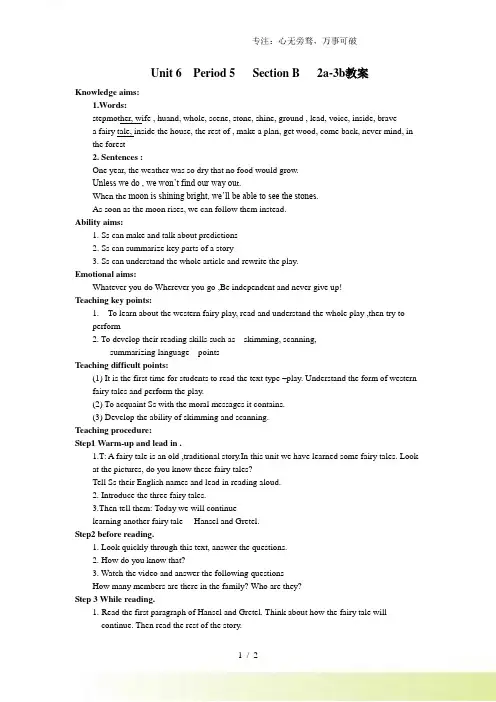
Unit 6 Period 5 Section B 2a-3b教案Knowledge aims:1.Words:stepmother, wife , huand, whole, scene, stone, shine, ground , lead, voice, inside, bravea fairy tale, inside the house, the rest of , make a plan, get wood, come back, never mind, inthe forest2. Sentences :One year, the weather was so dry that no food would grow.Unless we do , we won’t find our way ou t.When the moon is shining bright, we’ll be able to see the stones.As soon as the moon rises, we can follow them instead.Ability aims:1. Ss can make and talk about predictions2. Ss can summarize key parts of a story3. Ss can understand the whole article and rewrite the play.Emotional aims:Whatever you do Wherever you go ,Be independent and never give up!Teaching key points:1. To learn about the western fairy play, read and understand the whole play ,then try toperform2. To develop their reading skills such as skimming, scanning,summarizing language pointsTeaching difficult points:(1) It is the first time for students to read the text type –play. Understand the form of westernfairy tales and perform the play.(2) To acquaint Ss with the moral messages it contains.(3) Develop the ability of skimming and scanning.Teaching procedure:Step1 Warm-up and lead in .1.T: A fairy tale is an old ,traditional story.In this unit we have learned some fairy tales. Lookat the pictures, do you know these fairy tales?Tell Ss their English names and lead in reading aloud.2. Introduce the three fairy tales.3.Then tell them: Today we will continuelearning another fairy tale ---Hansel and Gretel.Step2 before reading.1. Look quickly through this text, answer the questions.2. How do you know that?3. Watch the video and answer the following questionsHow many members are there in the family? Who are they?Step 3 While reading.1.Read the first paragraph of Hansel and Gretel. Think about how the fairy tale willcontinue. Then read the rest of the story.2. Work on 2c.T: Now let’s read the play carefully and try to match each description below with the correct scene.Ss read the play quickly and try to match each description.3. Work on 2d Careful reading.Read the passage carefully and answer the following questions:Why does the wife tell her huand to leave the children in the forest?What does Hansel go out to get?Why does he do this in the moonlight?How do Hansel and Gretel find their way home?Why do Hansel and Gretel get lost the second time?4.At the same time write the key words from each scene and give the summary. Step 5 After reading.1.Guess what will happen and give the play an ending.Do you think they are in danger, why?What would happen when the old woman came out of the house?What will the brave children do?2. What do you think of Hansel and Gretel ?What can we learn form the fairy tale ?Step 6 Summarize and homework.。
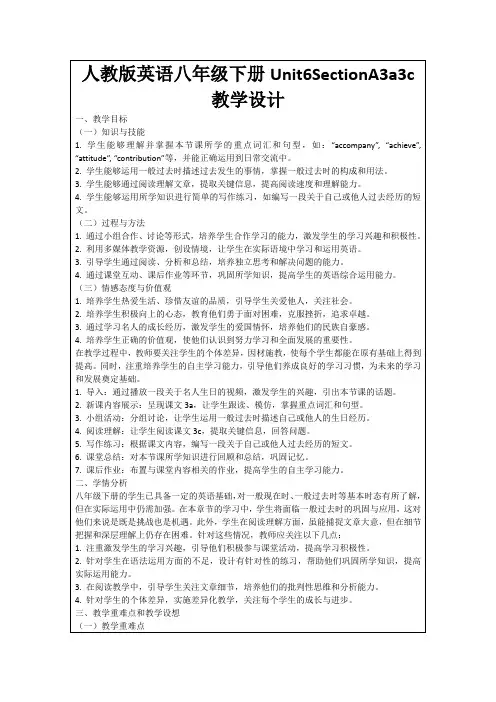
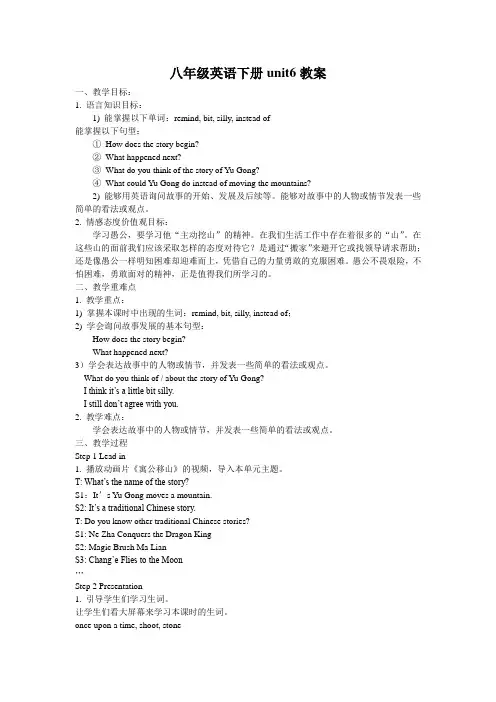
八年级英语下册unit6教案一、教学目标:1. 语言知识目标:1) 能掌握以下单词:remind, bit, silly, instead of能掌握以下句型:①How does the story begin?②What happened next?③What do you think of the story of Yu Gong?④What could Yu Gong do instead of moving the mountains?2) 能够用英语询问故事的开始、发展及后续等。
能够对故事中的人物或情节发表一些简单的看法或观点。
2. 情感态度价值观目标:学习愚公,要学习他“主动挖山”的精神。
在我们生活工作中存在着很多的“山”。
在这些山的面前我们应该采取怎样的态度对待它?是通过“搬家”来避开它或找领导请求帮助;还是像愚公一样明知困难却迎难而上,凭借自己的力量勇敢的克服困难。
愚公不畏艰险,不怕困难,勇敢面对的精神,正是值得我们所学习的。
二、教学重难点1. 教学重点:1) 掌握本课时中出现的生词:remind, bit, silly, instead of;2) 学会询问故事发展的基本句型:How does the story begin?What happened next?3)学会表达故事中的人物或情节,并发表一些简单的看法或观点。
What do you think of / about the story of Yu Gong?I think it’s a little bit silly.I still don’t agree with you.2. 教学难点:学会表达故事中的人物或情节,并发表一些简单的看法或观点。
三、教学过程Step 1 Lead in1. 播放动画片《寓公移山》的视频,导入本单元主题。
T: What’s the name of the story?S1:It’s Yu Gong moves a mountain.S2: It’s a traditional Chinese story.T: Do you know other traditional Chinese stories?S1: Ne Zha Conquers the Dragon KingS2: Magic Brush Ma LianS3: Chang’e Flies to the Moon…Step 2 Presentation1. 引导学生们学习生词。
八年级下册英语人教版第六单元教案全文共3篇示例,供读者参考篇1Unit 6: The Story of My VillageTeaching Objectives:1. Enable students to learn new vocabulary related to village life.2. Help students understand the simple past tense and practice using it in sentences.3. Develop students' listening, speaking, reading, and writing skills through various activities.Teaching Procedures:1. Warm-up (10 minutes):- Show students pictures of different villages around the world and ask them to describe what they see.- Discuss with students what they know about village life and compare it to their own experiences.2. Vocabulary Building (15 minutes):- Introduce new vocabulary related to village life, such as "farmers," "crops," "harvest," "livestock," etc.- Have students match the words with their meanings and practice using them in sentences.3. Listening Activity (20 minutes):- Play a recording of a person talking about their village and ask students to listen for specific details.- Have students answer questions about the information they heard and discuss it in pairs.4. Reading Comprehension (20 minutes):- Provide students with a passage about a village and have them read it silently.- Ask students questions about the main idea, details, and inferences in the text.5. Grammar Practice (15 minutes):- Introduce the simple past tense and explain the rules for forming regular and irregular verbs.- Have students practice using the simple past tense in sentences about village life.6. Speaking Exercise (15 minutes):- Divide students into pairs and have them take turns talking about their own village or a village they have visited.- Encourage students to use the new vocabulary and simple past tense in their descriptions.7. Writing Assignment (20 minutes):- Ask students to write a short paragraph describing a village they would like to visit.- Remind students to use the vocabulary and grammar they have learned during the lesson.8. Recap and Review (10 minutes):- Review the new vocabulary and grammar points with the class.- Allow students to ask any questions or share their thoughts on village life.Homework:- Assign students to write a diary entry about a day in the life of someone living in a village.- Encourage students to use the simple past tense and include the new vocabulary they have learned.Assessment:- Evaluate students based on their participation in class activities, understanding of the new vocabulary and grammar, and the quality of their written assignments.篇2Unit 6: TravelLesson 1: Travel DestinationsObjectives:- Students will learn vocabulary related to travel destinations.- Students will practice using the present perfect tense to talk about travel experiences.- Students will improve their speaking and listening skills through group discussions and role plays.Warm-up:Start the lesson by asking students about their dream travel destination. Encourage them to describe why they would like to visit that place and what they hope to do there.Vocabulary:Introduce new vocabulary related to travel destinations such as beach, mountains, city, countryside, historical sites, and landmarks. Use pictures and realia to help students understand the meanings of these words.Grammar focus:Explain and review the present perfect tense with students, emphasizing its usage to talk about travel experiences. Provide examples and ask students to practice forming sentences using the present perfect tense.Speaking activity:Divide the class into pairs or small groups and have them discuss the following questions:- Have you ever traveled to a foreign country?- What was your favorite travel destination and why?- What is on your travel bucket list?Role play:In groups of three or four, have students role play a conversation between travelers discussing their past travel experiences. Encourage them to use the present perfect tense in their dialogue.Homework:Ask students to write a short paragraph about their dream travel destination, using the present perfect tense to talk about any travel experiences they have had.Lesson 2: Planning a TripObjectives:- Students will learn vocabulary related to planning a trip.- Students will practice using modal verbs to make suggestions and give advice.- Students will improve their reading and writing skills through a travel planning activity.Warm-up:Review the vocabulary from the previous lesson by asking students to brainstorm a list of items they would need for a trip.Encourage them to categorize the items into must-have, should-have, and nice-to-have.Vocabulary:Introduce new vocabulary related to planning a trip such as itinerary, accommodations, transportation, attractions, and activities. Provide examples and ask students to practice using the words in sentences.Grammar focus:Explain and review modal verbs such as should, could, and must for making suggestions and giving advice. Provide examples and ask students to practice using the modal verbs in context.Reading activity:Distribute a travel itinerary to each student and have them read the details carefully. Ask comprehension questions to check their understanding of the itinerary.Writing activity:In pairs or small groups, have students create their own travel itinerary for a trip to a fictional destination. Encouragethem to include details such as accommodations, transportation, attractions, and activities.Homework:Ask students to write a short essay about their dream trip, using modal verbs to make suggestions and give advice on what to do and see.Lesson 3: Travel StoriesObjectives:- Students will learn vocabulary related to travel experiences.- Students will practice using the past simple tense to narrate travel stories.- Students will improve their listening and speaking skills through storytelling activities.Warm-up:Start the lesson by asking students to share a memorable travel experience they have had in the past. Encourage them to describe the place they visited, what they did there, and how they felt.Vocabulary:Introduce new vocabulary related to travel experiences such as adventure, cultural exchange, cuisine, hospitality, and souvenirs. Use pictures and realia to help students understand the meanings of these words.Grammar focus:Explain and review the past simple tense with students, emphasizing its usage to narrate travel stories. Provide examples and ask students to practice forming sentences using the past simple tense.Listening activity:Play a recording of a travel story and have students listen carefully. Ask comprehension questions to check their understanding of the story.Speaking activity:In pairs or small groups, have students take turns narrating their own travel stories using the past simple tense. Encourage them to include details such as the setting, characters, events, and emotions.Homework:Ask students to write a short paragraph summarizing a travel story they have heard or read, using the past simple tense to narrate the events.Overall, this unit is designed to help students improve their English skills while learning about travel destinations, planning trips, and sharing travel stories. By the end of the unit, students should feel more confident in using vocabulary related to travel and expressing themselves fluently in English.篇3Unit 6: I'm watching TVPart one: Teaching goals1. Enable students to master the new words and phrases.2. Help students understand and use the present continuous tense.3. Encourage students to describe ongoing actions using the present continuous tense.Part two: Teaching key points1. Vocabulary: New words and phrases related to daily activities and actions.2. Grammar: Present continuous tense and its usage.3. Speaking: Encouraging students to use the present continuous tense to describe ongoing actions.Part three: Teaching difficult points1. Differentiating between the present simple tense and the present continuous tense.2. Encouraging students to form questions and negative sentences using the present continuous tense.3. Guiding students to express ongoing actions in a clear and concise manner using the present continuous tense.Part four: Teaching methods1. Task-based learning: Engaging students in various activities to practice using the present continuous tense.2. Group work: Encouraging students to work together to complete tasks and exercises related to the lesson.3. Role-playing: Providing scenarios for students to act out using the present continuous tense.4. Visual aids: Using pictures, videos, and realia to help students understand and remember new vocabulary and sentence structures.Part five: Teaching procedures1. Warm-up activity: Introducing the topic of daily activities and actions.2. Vocabulary introduction: Presenting new words and phrases related to daily activities.3. Grammar explanation: Introducing the present continuous tense and its formation.4. Practice activities: Engaging students in exercises to practice forming sentences using the present continuous tense.5. Group work: Dividing students into groups to complete tasks using the present continuous tense.6. Role-playing: Providing scenarios for students to act out using the present continuous tense.7. Review: Going over the key points of the lesson and providing additional practice exercises.8. Homework: Assigning tasks for students to practice using the present continuous tense in writing.Part six: Assessment1. Observing students' participation in class activities.2. Assessing students' understanding of the present continuous tense through exercises and tasks.3. Reviewing students' homework assignments to evaluate their use of the present continuous tense in writing.Part seven: ConclusionBy the end of this unit, students should be able to accurately use the present continuous tense to describe ongoing actions and activities. They should also be able to differentiate between the present simple tense and the present continuous tense. Through various activities and exercises, students will have the opportunity to practice using the present continuous tense in both spoken and written forms.。
八下英语人教unit 6教案教案标题:Unit 6: I'm going to study computer science.教学目标:1. 语言目标:学生能够掌握并正确运用本单元的词汇和短语,如computer science, astronaut, engineer, etc. 学生能够运用一般将来时表达自己的未来计划。
2. 情感目标:培养学生对未来职业的兴趣和探索,激发学生的职业理想和目标。
教学重点:1. 学习并正确运用本单元的词汇和短语。
2. 学习并正确运用一般将来时表达自己的未来计划。
教学难点:1. 运用一般将来时表达自己的未来计划。
2. 运用本单元的词汇和短语进行口语和写作表达。
教学准备:1. 教材:《人教版英语》八年级下册2. 多媒体设备3. 学生练习册教学过程:Step 1: Warm-up (5 minutes)1. Greet the students and review the previous lesson's vocabulary related to future plans.2. Show pictures of different occupations and ask students what they want to bein the future. Encourage them to explain why they are interested in thoseoccupations.Step 2: Presentation (15 minutes)1. Introduce new vocabulary words related to future occupations, such as computer science, astronaut, engineer, etc. Use pictures, gestures, and real-life examples to help students understand the meanings.2. Present the structure of the future tense using "be going to." Explain the usage and form of this tense.3. Provide examples of sentences using the future tense and ask students to identify the structure and meaning.Step 3: Practice (20 minutes)1. Divide the class into pairs or small groups and give each group a list of future occupations.2. Students take turns asking and answering questions about their future plans using the future tense. Encourage them to use the new vocabulary words.3. Monitor the groups and provide assistance when needed.Step 4: Production (15 minutes)1. Ask students to write a short paragraph about their future plans using the future tense and the vocabulary words from the unit.2. Encourage students to be creative and explain why they are interested in their chosen occupation.3. Allow some students to share their paragraphs with the class if time permits. Step 5: Review and Closure (5 minutes)1. Review the key vocabulary words and the structure of the future tense withthe whole class.2. Summarize the main points of the lesson and ask students if they have any questions or need further clarification.教学延伸:可以邀请一些职业人士来学校,与学生分享他们的职业经历和对未来的展望,以激发学生对不同职业的兴趣和理解。
初中英语Go For It! 教材八年级(下)Unit 6的教学设计一、教学内容分析本课时的内容是以慈善活动“滑冰马拉松”的新闻报道为主题,通过以读促说的教学目的展开话题。
二、教学目标1、语言目标词汇:skater raise several句型:How long have you been doing something?I have been doing something for/since….When did you start doing something?2、情感目标通过阅读使学生树立和加强积极参加慈善活动的意识,了解马拉松作为慈善活动之一的文化内涵。
3、能力目标以读促说,培养学生的读说能力。
通过对以滑冰马拉松这一慈善题材的阅读,促进学生在一定的语境中运用现在完成进行时和一般过去时进行语言的输出和交流。
阅读中渗透阅读策略,培养学生分析问题、解决问题的能力。
三、教学重、难点1、在特定的语境中正确运用现在完成进行时和一般过去时进行语言交流。
2、对发生的事情进行现场报道。
四、教学方法任务型教学法,情景教学法,交际法。
五、教学步骤------------------------------WorkSheet--------------------------A. It’s 2 pm. Read the passage and plete the following table.B.GroupworkDo a survey about what charity activities your classmates take part in.1.Show your survey.2.Give a news report.I’m talking to you from HuandongSchool. Here,students are making a survey….In m y group,...Thank you for joining us.课后反思遵循原则,解读文本,渗透策略,培养以读促说能力---2010省初中英语阅读教学展示与研讨活动有感这次有幸参加了某某省初中英语阅读教学展示与研讨活动,并亲自承担了展示课的任务。
Unit6An old man tried to move the mountains.第一课时Section A(1a2d)【学习目标】1.重点单词:shoot,begin,god,remind,bit,silly2.重点短语:Journey to the West,Yu Gong Moves a Mountain,Hou Yi shoots the Suns,Nu Wa Repairs the Sky,once upon a time,instead of,work on,a little bit3.重点句式:An old man tried to move the mountains.How does the story begin?Where would they put all the earth and stone from the mountains?As soon as the man finished talking,Yu Gong said that his family could continue to move the mountains after he died.Finally,a god was so moved by Yu Gong that he sent two gods to take the mountains away.It doesn't seem very possible to move a mountain.The story is trying to show us that anything is possible if you work hard.Yu Gong kept trying and didn't give up.I think we should try to find other ways to solve a problem.What could Yu Gong do instead of moving the mountains?That's better and faster than moving a mountain!You have different opinions about the story,and neither of you are wrong.There are many sides to a story and many ways to understand it.【学习重点】1.重点短语和句型2.unless,so...that,as soon as...等的用法【学习难点】1.重点短语和句型2.unless,so...that,as soon as...等的用法【自学学习】一、预习课本P4142新单词并背诵,完成下面的汉译英。
“三新”课堂比赛教学设计
Unit 6 An old man tried to move the
mountains.
参赛学校:直滩初级中学
参赛教师:卢雪平
Unit 6 An old man tried to moved the mountains.
Section A 1 (1a-1c)
Designer : Lu Xuepijng
Teaching Aims:
1. Knowledge Objects:
1) Master these words:shoot, once upon a time, stone,dig,hold.
2) Ss can use the structures:
① How does the story begin?
② What happened next?
2. Ability Objects:
Ss can use English to ask the beginning, the presentation and results of stores. 3. Moral Objects:
Ss will learn to face the problems in their schoolwork and their own life just like Yu Gong. And they should find out the correct way to deal with them.
Teaching focus & difficulties
1. Teaching focus:
1) The new words:shoot, once upon a time, stone,dig,hold.
2) the structures:
How does the story begin?
What happened next?
2. Teaching difficulties
Ss can use English to ask the beginning, the presentation and results of stores. And retell the simple stories.
Teaching Aids
A tape recorder, multimedia
Teaching Procedure:
Step 1 Lead in
1. Play the video of Yu Gong moves the mountains to lead in.
T: What’s the name of the story?
S1:It’s Yu Gong moves a mountain.
S2: It’s a traditional Chinese story.
T: Do you know other traditional Chinese stories?
S1: Ne Zha Conquers the Dragon King
S2: Magic Brush Ma Lian
S3: Chang’e Flies to the Moon
…
Step 2 Presentation
1. Look at the pictures and guess the English names.
(the main character)
2. Match the pictures with the English names.
3. Read the names of the story in the box.
Step 3 Listening
1.Before listening
1) Learn the new words in the listening: once upon a time, stone,
so…that, hold,dig,earth.
2) Guess the main idea from the title and the three sentences.
3) Circle the key words in each sentence.
2. While listening
1) Play the tape for the first time to get the main idea.
2) Play again and check the answers.
3. After listening
1) Role- play the conversation in the listening.
2) Read it by themselves
3) Encourage Ss to retell the story.
Step 4 Pair work
1. Read the questions in the box in 1c.
2. Ss discuss the questions with their partners.
3. Let some pairs ask and answer the questions.
e.g. A: How does the story happen?
B: There were two very tall mountains in front of their house.
A: What happened next?
B: A very old man tried to move the mountains.
A: Where would they put all the earth and stone from the mountains?
B: They would put them into the sea.
Homework:
1. Recite the conversation in 2d after school.
2. Tell the story Yu Gong Moves a Mountain in English to your parents. Once upon a time, there was a very old man…
Blackboard Design :。